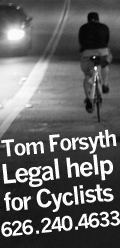Korean Bike Ninjas

Thread started by
trickmilla at 06.11.08 - 1:02 pm
 STORY HERE
STORY HERE
Note: this article is part of this week’s EcoWorldly cycling series: Cycling and its importance in countries around the world.
In South Korea, it’s easy to tell a toned, avid cyclist when you see one. You’ll know by his killer ninja looks.
Underneath the cyclist’s sleek helmet: a bandanna. Below the rim of the bandanna: steely sunglasses. Wrapping from the bandanna to cover the rest of the face: a hard face mask.
All in all, the cycling outfit looks like something straight out of a ninja movie. But what battles are there for a modern day bicycle ninja to fight? Just as in a Hollywood film, these ninja lookalikes toil to protect the young and the old from a common threat. And as it turns out, that ninja-like mask and outfit isn’t just for show. It protects bicyclists from a very real enemy.
What enemy do bicycle ninjas fight? Air pollution from car exhaust. Air pollution levels in Korea’s cities are serious and sometimes fatal.
There is a strong and increasingly clear connection between car exhaust and life-threatening lung conditions. In South Korea, the number of deaths from lower respiratory conditions nearly doubled from 1992 to 2002. Worldwide, the World Health Organization estimates that 3 million people a year die from diseases related to air pollution. And this isn’t just in far-off countries. It includes Americans, Chinese, French, South Koreans, etc. In South Korea, asthma in particular is becoming more common. Currently, 3.9% of the population as a whole suffers from asthma. This number grows to around 12% for young children and the elderly.
Therefore, South Korea’s ninja cyclists are fighting a worthy battle. Forgoing the car, they ride together, emitting no pollution and encouraging others to do the same.
Where do South Korean Bicycle Ninjas Do Battle?
South Korea, while not a bicyclists haven, does offer some wonderful bike routes and options. Three of the best include:
Rice Paddies. There’s nothing like cycling through the rice paddies in the morning. Though I wouldn’t say that I’m a full fledged bicycle ninja myself (I lack the proper ninja attire), I regularly enjoy bicycling through the rice paddies to the north of my house. Smoothly paved bike lanes with well-marked bicycle signs designate these and other rice paddies in South Korea as a great bike route.
The Cheonggyecheon greenway. A newly restored 6 km greenway runs alongside the Cheonggyecheon stream in the heart of Seoul’s urban jungle. It’s a marvelous place for a stroll as well as a bike ride. Just relax and peddle slowly; the Cheonggyecheon stream is also a favorite walkway for pedestrians, and as Mark Seall’s article earlier this week showed, it’s important not to traumatize pedestrians with your ninja biking skills.
Secondary and tertiary roadways. South Korea is full of farming roads, small side-roads, and other paved surfaces with few cars. Bicycling along these roads, I’ve found, is by far the best way to discover hidden temples and forgotten neighborhoods.
There are many other wonderful areas to explore by bike. Meanwhile, you’ll know that you’re taking a humble but important stance against air pollution.
Bike on, bicycle ninjas. Bike on.
![]() MORE IMAGES HERE
reply
MORE IMAGES HERE
reply
The bicycle capital of South Korea is Sang-ju.
In the downtown core some of the streets around the market are blocked to motor vehicles and on the main street there are bike racks every 100 meters -- which are heavily used. City official say that there are about 85,000 bicycle in the city. An average of two bicycles per household.
The number of students using bicycles is given as approximately 14,000. When the school day ends they flood the streets heading in all directions.
You can read more and see some pics
HERE
I spent a month in South Korea earlier this year and I was very impressed with the diversity of cyclists. You get your ninjas, students, mothers and cargo haulers. All of which seemed unconcerned about riding in super dense, super unpredictable traffic conditions.
Scooters seem to outnumber cars on a 2:1 ratio, so I think that making that leap from 2 wheels to 2 wheels is much easier.
The wife and I rented bikes when we could (all of which were of the mountain variety) and spent some time exploring the vast farmlands. TONS of riding to be had. No cars unless you choose to get on a highway. The most common things we found ourselves avoiding were tractors and herbs layed out on the asphalt to dry in the sun.
 Eric Hair
Eric Hair06.11.08 - 4:32 pm
reply
 -->
-->




